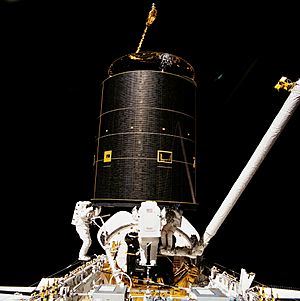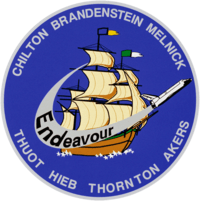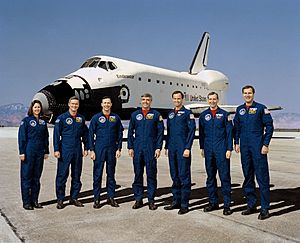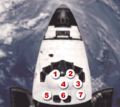STS-49 facts for kids

Richard Hieb, Thomas Akers, and Pierre Thuot working together to grab the Intelsat 603 satellite.
|
|
| Names | Space Transportation System-47 |
|---|---|
| Mission type | Intelsat-603 satellite repair |
| Operator | NASA |
| Mission duration | 8 days, 21 hours, 17 minutes, 38 seconds |
| Distance travelled | 5,948,166 km (3,696,019 mi) |
| Orbits completed | 141 |
| Spacecraft properties | |
| Spacecraft | Space Shuttle Endeavour |
| Launch mass | 116,390 kg (256,600 lb) |
| Landing mass | 91,279 kg (201,236 lb) |
| Payload mass | 16,984 kg (37,443 lb) |
| Crew | |
| Crew size | 7 |
| Members |
|
| Start of mission | |
| Launch date | 7 May 1992, 23:40:00 UTC |
| Rocket | Space Shuttle Endeavour |
| Launch site | Kennedy Space Center, LC-39B |
| Contractor | Rockwell International |
| End of mission | |
| Landing date | 16 May 1992, 22:57:38 UTC |
| Landing site | Edwards Air Force Base, Runway 22 |
| Orbital parameters | |
| Reference system | Geocentric orbit |
| Regime | Low Earth orbit |
| Perigee | 268 km (167 mi) |
| Apogee | 341 km (212 mi) |
| Inclination | 28.32° |
| Period | 90.60 minutes |
 STS-49 mission patch  Kathryn C. Thornton, Bruce E. Melnick, Pierre J. Thuot, Daniel C. Brandenstein, Kevin P. Chilton, Thomas D. Akers, Richard J. Hieb |
|
STS-49 was the very first flight of the Space Shuttle Endeavour. It launched on May 7, 1992. The main goal of this nine-day mission was to fix a satellite called Intelsat 603. This satellite had gotten stuck in a low orbit two years earlier. The astronauts needed to grab it, attach a new rocket part, and then send it to its correct, higher orbit. After a few tries, the astronauts successfully captured the satellite. This mission featured the only time in space history that three astronauts worked together outside the spacecraft at once. It was also one of the longest spacewalks ever at that time.
Contents
Meet the Astronauts
The STS-49 mission had a crew of seven brave astronauts:
- Daniel C. Brandenstein (Commander) - His fourth and final flight.
- Kevin P. Chilton (Pilot) - His first flight into space.
- Richard J. Hieb (Mission Specialist) - His second flight.
- Bruce E. Melnick (Mission Specialist) - His second and final flight.
- Pierre J. Thuot (Mission Specialist) - His second flight.
- Kathryn C. Thornton (Mission Specialist) - Her second flight.
- Thomas D. Akers (Mission Specialist) - His second flight.
Spacewalks: Working Outside the Shuttle
Astronauts go on spacewalks, also called Extravehicular Activities (EVAs), to work outside their spacecraft. The STS-49 mission had four spacewalks, which was a record at the time.
- Spacewalk 1: Thuot and Hieb
- Date: May 10–11, 1992
- Duration: 3 hours, 43 minutes
- Goal: Try to attach a special bar to the Intelsat satellite. They couldn't do it this time.
- Spacewalk 2: Thuot and Hieb
- Date: May 11–12, 1992
- Duration: 5 hours, 30 minutes
- Goal: Another try to attach the bar to the satellite. This attempt also didn't work.
- Spacewalk 3: Thuot, Hieb, and Akers
- Date: May 13–14, 1992
- Duration: 8 hours, 29 minutes
- Goal: This was a special, unplanned spacewalk with three astronauts. Commander Brandenstein carefully moved the Endeavour very close to the satellite. Thuot, Hieb, and Akers were able to grab the satellite by hand! This was a huge success.
- Spacewalk 4: Thornton and Akers
- Date: May 14–15, 1992
- Duration: 7 hours, 45 minutes
- Goal: This spacewalk was part of an experiment called ASEM. It helped show how astronauts could build and fix parts of a future space station.
Mission Highlights: Fixing a Satellite in Space
The main goal of STS-49 was to fix the Intelsat 603 satellite. This satellite was supposed to go into a high orbit, but it got stuck in a low orbit in 1990. The astronauts had to capture it and give it a new rocket engine to send it to its correct place.
The capture was very difficult. Astronauts Thuot and Hieb tried twice to attach a special capture bar to the satellite using the Shuttle's robotic arm, the Canadarm. Both attempts failed.
Because of these difficulties, the mission was extended by two days. On the third attempt, something amazing happened. Three astronauts – Thuot, Hieb, and Akers – went out together on an unplanned spacewalk. Commander Brandenstein flew the Endeavour incredibly close to the satellite. The three astronauts then worked together to grab the large, 4,215 kg (9,292 lb) satellite by hand! After they captured it, they attached the new rocket engine. The satellite was then released, and its new engine fired, sending it to its proper orbit.
The crew also set up a special structure in the Shuttle's cargo bay. This structure, called ASEM, helped them during the hand capture. It also allowed astronauts Thornton and Akers to practice building and maintaining parts for the future Space Station Freedom.
Other experiments on the mission included studying how proteins grow crystals in space and taking pictures of rocket plumes.
This mission set several new records:
- It was the very first flight of the Space Shuttle Endeavour.
- It featured the first (and only) spacewalk with three astronauts.
- Two of the spacewalks (8 hours, 29 minutes and 7 hours, 45 minutes) were the second and fourth longest ever at that time.
- It was the first Shuttle mission to have four spacewalks.
- It had the second longest total spacewalk time for a single Shuttle mission (25 hours and 27 minutes).
- It was the first Shuttle mission that had to meet up with an orbiting spacecraft three times.
- It was the first time a special drogue parachute was used during a Shuttle landing to help it slow down.
Wake-up Calls: Music in Space
NASA started a fun tradition of playing music to wake up astronauts during the Project Gemini missions. A special song is chosen for each day in space. Often, the astronauts' families choose the songs. The music can have a special meaning or relate to the day's activities.
| + | Day | Song | Artist/Composer | Played For |
|---|---|---|---|---|
| Day 2 | "God Bless the U.S.A." | Lee Greenwood | ||
| Day 3 | "Rescue Me" | Fontella Bass | ||
| Day 4 | "Theme from Winnie the Pooh" | Kathy Thornton (from her Children on Mother's Day) | ||
| Day 5 | "Gonna Fly Now (Theme from Rocky)" | Bill Conti | ||
| Day 6 | "Kokomo" | The Beach Boys | ||
| Day 7 | No song | |||
| Day 8 | "I wake up with a smile on my face" | Boxcar Willie | ||
| Day 9 | "Son of a Son of a Sailor" | Jimmy Buffett |
Images for kids
See also
 In Spanish: STS-49 para niños
In Spanish: STS-49 para niños





